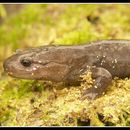en
names in breadcrumbs


Development - Life Cycle: metamorphosis
Other Physical Features: ectothermic ; bilateral symmetry
Key Reproductive Features: gonochoric/gonochoristic/dioecious (sexes separate)
The Asiatic salamanders (family Hynobiidae) are primitive salamanders found all over Asia, and in European Russia. They are closely related to the giant salamanders (family Cryptobranchidae), with which they form the suborder Cryptobranchoidea. About half of hynobiids currently described are endemic to Japan.[1]
Hynobiid salamanders practice external fertilization, or spawning. And, unlike other salamander families which reproduce internally, male hynobiids focus on egg sacs rather than females during breeding.[2] The female lays two egg sacs at a time, each containing up to 70 eggs. Parental care is common.[3]
A few species have very reduced lungs, or no lungs at all. Larvae can sometimes have reduced external gills if they live in cold and very oxygen-rich water.[4]
Fossils of hynobiids are known from the Miocene to the present in Asia and Eastern Europe, though fossils of Cryptobranchoids more closely related to hynobiids than to giant salamanders extend back to the Middle Jurassic.[5]
Cladograms based on the work of Pyron and Wiens (2011)[6] and modified using Mikko Haaramo [7]
HynobiinaeCurrently, 81 species are known. These genera make up the Hynobiidae:
Subfamily Hynobiinae
Subfamily Onychodactylinae
The Asiatic salamanders (family Hynobiidae) are primitive salamanders found all over Asia, and in European Russia. They are closely related to the giant salamanders (family Cryptobranchidae), with which they form the suborder Cryptobranchoidea. About half of hynobiids currently described are endemic to Japan.
Hynobiid salamanders practice external fertilization, or spawning. And, unlike other salamander families which reproduce internally, male hynobiids focus on egg sacs rather than females during breeding. The female lays two egg sacs at a time, each containing up to 70 eggs. Parental care is common.
A few species have very reduced lungs, or no lungs at all. Larvae can sometimes have reduced external gills if they live in cold and very oxygen-rich water.
Fossils of hynobiids are known from the Miocene to the present in Asia and Eastern Europe, though fossils of Cryptobranchoids more closely related to hynobiids than to giant salamanders extend back to the Middle Jurassic.